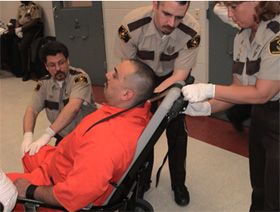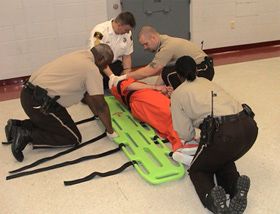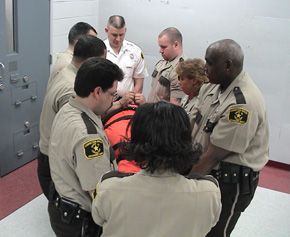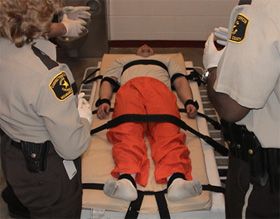A C1 Member Asks: I work in a 40-person jail. We have padded cells but no restraint chairs.
In other jails, I have seen two types of restraint chairs. One is black plastic with a recessed area for handcuffs in back. It looks similar to the molded seats we use in our vehicle cages, except that it has additional belts and a strap for the feet. The other is gray vinyl, looks padded, has black arm rests with straps on them, shoulder and leg straps, and big wheels in back. The seat and back look flat. It looks like something that might be used in a hospital.
I have seen either one in use, but the black one looks like it would be easier to get a prisoner into, and might be easier to disinfect. Do you have any opinions as to which type is better, in terms of ease of use, durability and effectiveness (I’ve seen newspaper reports of prisoners escaping from restraint chairs)?
Gary Klugiewicz responds:
There are several restraint chairs on the market. You are asking the right questions when you evaluate a restraint chair based on the ability to sanitize it, the ease of application, its durability and ability to keep the prisoner secure. There are other questions that you need to research, as well.
For instance, does the back support/head rest adequately support the prisoners head and neck? Can the inmate’s head be forced backwards, intentionally or unintentionally causing injury to the inmate?
A second question has to do with the mobility of the restraint chair. i.e., how easy is it to move from one location to another?
A third question has to do with the stability of the restraint chair. How easy can it be overturned during movement or by the agitated movement of the prisoner in it? Some of restraint chairs actually have ground or wall stabilization points to help to prevent the prisoner from being able to turn it on its side.
These are all important questions.
 |
Restraint chairs need to protect the prisoner’s head and neck
Since all defensive tactics, including the use of restraints, are a matter of opinion, it stands to reason that there are some correctional trainers who recommend the use of the restraint chair while some do not. As with any restraint system, there are many benefits of restraints chairs, as well as shortcomings. You may want to consider alternatives to restraint chairs.
My experience from working at a large urban direct supervision facility and being an instructor trainer for correctional defensive tactics instructors is that a RIPP Restraint backboard system with a gurney system in conjunction with a RIPP Restraint bed works well.
Since most violent altercations necessitating the full restraint of a prisoner end up on the ground, a backboard allows you to roll the prisoner onto the backboard rather than having to get someone up off the ground and place a often combative prisoner into a restraint chair.
 |
Backboard allows you to roll the prisoner into it
This backboard can then be carried or rolled on a gurney to a more secure location where, in conjunction with a restraint bed, long-term restraint can be implemented.
 |
The backboard system can also be carried right into the cell and be moved easily up or down stairs. This proved advantageous at my facility, where there were second-floor cells in the living areas.
 |
Backboard can be used with gurneys to move prisoners
Remember that once a prisoner is restrained in a restraint chair, backboard, or restraint bed, long term monitoring must be implemented according to your institutions restraint and medical policies.
, a Wisconsin based correctional policy and liability trainer, “Restraints are to be used only for the purpose of control, never as a form of punishment or discipline. Remove the prisoner from restraints when the reason for placement in restraints has passed and it is safe to do so.”
 |
Backboard can be used in conjunction with restraint beds.
In conclusion, although it is important for correctional staff to control inmates in their “care & custody,” your facility needs to research the type of equipment that best fits your needs, train staff to properly use these restraints, set policy on how and when this equipment should be used, and properly supervise their use. The use of special restraints must be properly documented, as well. Remember: if you don’t write it down and it would make you look good it didn’t happen.
My thanks to the corrections officers of the Milwaukee County Sheriff’s Office Franklin Facility for their assistance in the photographs contained in this tactical tip.












